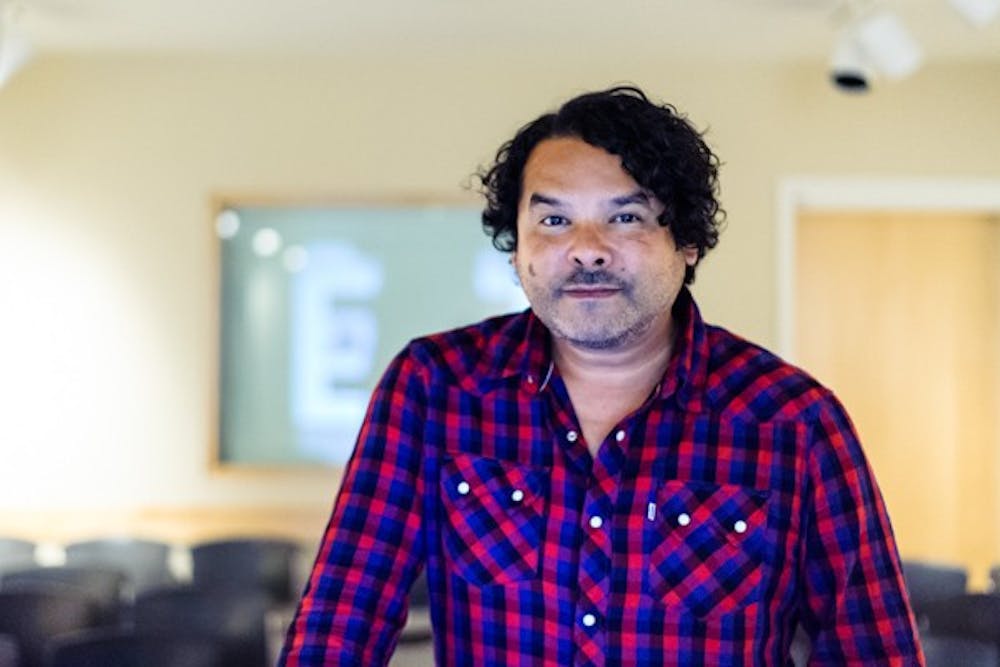 ASU Art Museum curator Julio César Morales poses for a portrait after giving a presentation in the Art Museum’s multipurpose room on Sept. 16. Morales’ event, entitled “México: Politica y Poética”, was a primer for a larger, museum-sponsored trip to Mexico City in February of 2015 that will explore the city’s art and architecture. (Photo by Ben Moffat)
ASU Art Museum curator Julio César Morales poses for a portrait after giving a presentation in the Art Museum’s multipurpose room on Sept. 16. Morales’ event, entitled “México: Politica y Poética”, was a primer for a larger, museum-sponsored trip to Mexico City in February of 2015 that will explore the city’s art and architecture. (Photo by Ben Moffat)At the ASU Art Museum on Tuesday evening, a group of students and adults were given a rare opportunity to cross the border into Mexico City, no visa required.
Julio Cesar Morales, a curator at the ASU Art Museum, spoke to listeners about artists from Latin America, their projects, the sometimes-alarming messages that their projects portrayed and about an opportunity for students to travel abroad next year to Mexico City.
Morales began by showing the audience work by José Guadalupe Posada, an artist from Mexico City who was famous for the overtly political messages found in his art.
“You don’t need text," Morales said. "You don’t need a specific story to tell you about what the picture means. It was supposed to be visual literacy, where people didn’t have to read the newspaper; they would see these murals to keep them informed about what was going on within Mexico during The Revolution.”
Morales said artists have always been drawn to Mexico City, because it is “alive, it is beautiful, it is kind of f----d up, and there is a lot of amazing energy that is happening there.”
Morales went on to show pieces from Miguel Angel Rios, Francis Alÿs, Teresa Margolles and Yoshua Okón, all of whom have either been born in or come to Mexico City, and all of whom have art that is very focused on borders.
When Americans think of a border, the first thing that comes into most of their minds is the border between America and Mexico. In reality, there are borders everywhere in the world, keeping outsiders out and keeping those who belong there in, said Rossi Todorova, development coordinator at the ASU Art Museum.
“It’s not only the U.S.-Mexico border that we’re talking about," she said. "That’s just one border. Even an artist living in Mexico City going somewhere else in Mexico has to face borders.”
Art’s job is to break these borders and to allow people to see across a wall that they might not be able to see over otherwise.
“By viewing artwork, you can understand people better,” Todorova said. “Most of the time with art, you’re not taking a side. Artwork can present a question rather than take a side. Through that posing of a question, it opens up the ability for you to understand how other artists that are dealing with violence in Mexico are addressing how they see the world around them.”
Gordon Knox, museum director at ASU Art Museum, said an exhibit about Latin American art is so important to have in Arizona because of the geographical and cultural resonance it has throughout the Phoenix area.
“Arizona was Mexican for 200 years before it became American,” Knox said. “Its largest and strongest trade partner is Mexico, and there are many cultural connections, and so understanding the cultural turbulence and transformations taking place in Mexico City is really very much like understanding the activities beyond Arizona that have a direct effect on Arizona.”
Morales and Knox both stressed what an amazing opportunity going on the study abroad trip to Mexico City would be.
“It’s going to be an absolutely exclusive, cultural investigation into the contemporary artwork of Mexico, as well as contemporary culture including restaurants and music and so forth,” Knox said. “But the real opportunity here, the thing that can never be reproduced, is that we have Julio activating an incredible network of top artists that are working in Mexico today."
Morales said the study abroad trip would visit most of the artists exhibited at the event.
The chance to visit Mexico City with such knowledgeable guides who have so many connections is one that only comes once in a lifetime.
“You’ll be inspired by the city,” Morales said. “With all its flaws and chaos and beauty, there’s so much from it that you’ll be able to take away something phenomenal from the city.”
Reach the reporter at fdenaple@asu.edu or follow her on Twitter @FreesiaDeNaples
Like The State Press on Facebook and follow @statepress on Twitter.




